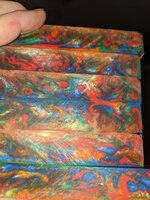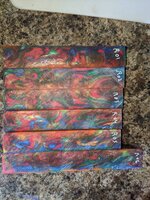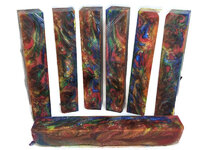ctfolmar
Member
I see many blanks where the resin colors are very sharply defined, almost like they were made with multiple casts. Camo blanks for instance. How is that accomplished?

Those blanks may not be what you expected, but they sure are pretty!Commercially made blanks like the camo series are a different type of plastic from what we use in our shops. I agree that they are often using ribbons / films to keep colors separate. I've looked closely at some and found a very thin clear layer between colors. The resins we ( home casters ) use are thin and set quick. I don't believe we have the working time commercial plastic have or the ability to work it like they do in their automated process. Most of us pour like in the video above (with individual techniques). It all depends on what results you want.... large swirls, small tight swirls, tiger stripes, color transitions, and so on. There are many ways to do this depending on what results your striving for. You can use the same colors in several pours and get different results from each depending on your technique.... vertical pour, flat bowl pour, flip cup pour, individual cup pour, pour them together and then pour, stir after you pour, directional pours, spin the mild as you pour, how high you pour from...and so on. The biggest thing to remember is if you pour too soon, your colors mix to create a new color, too late and you get a blob with air bubbles trapped inside. Also, dont pay too much attention to the photos only showing the top of the poured blocks. The top looks cool but rarely ever reveals what the inside looks like. Here's a photo of the top and then the inside of some I poured. The churning curing resin makes a cool pattern but it doesn't look like that inside.
I've been using mica powder but am interested in using what you are using. What is the color line/company? Thank youI don't think I would call the result "perfect", but here's an attempt at better separation:



No!! Let us know what it is and let us see it so we can learn from it.I've got an idea I want to try but I'm going to experiment first so if it's an abysmal failure y'all won't see it! [emoji6]
Stay tuned.
Sent from my SM-G955U using Tapatalk
